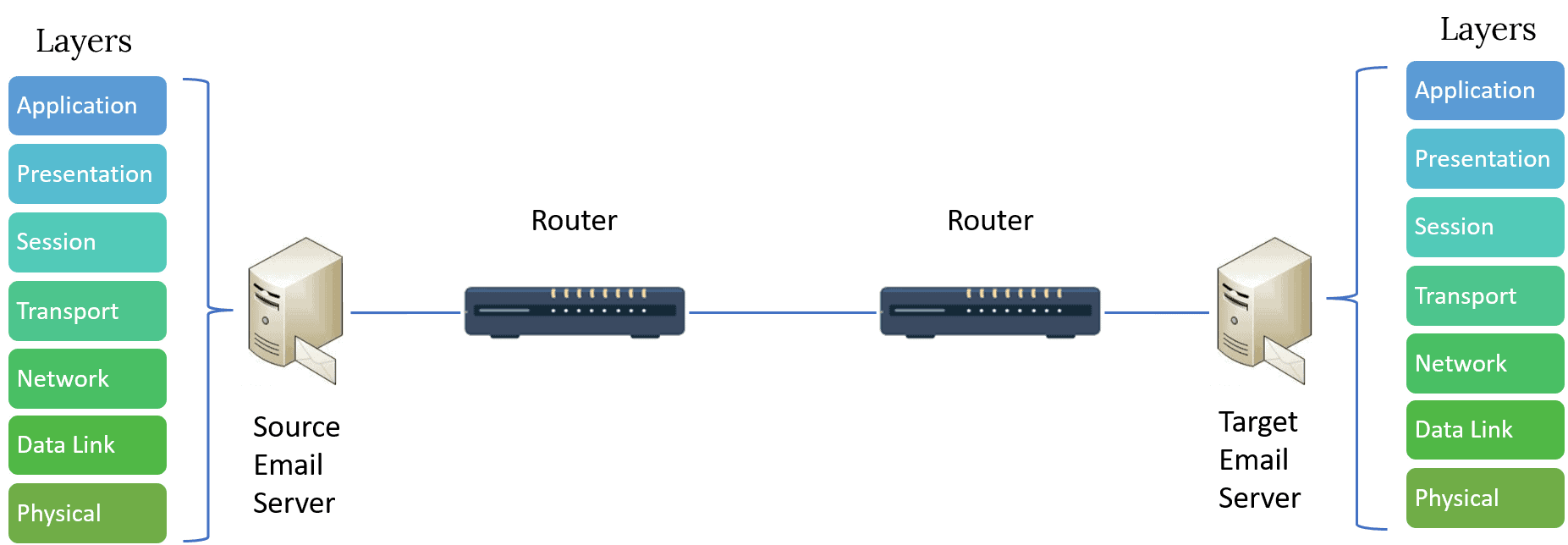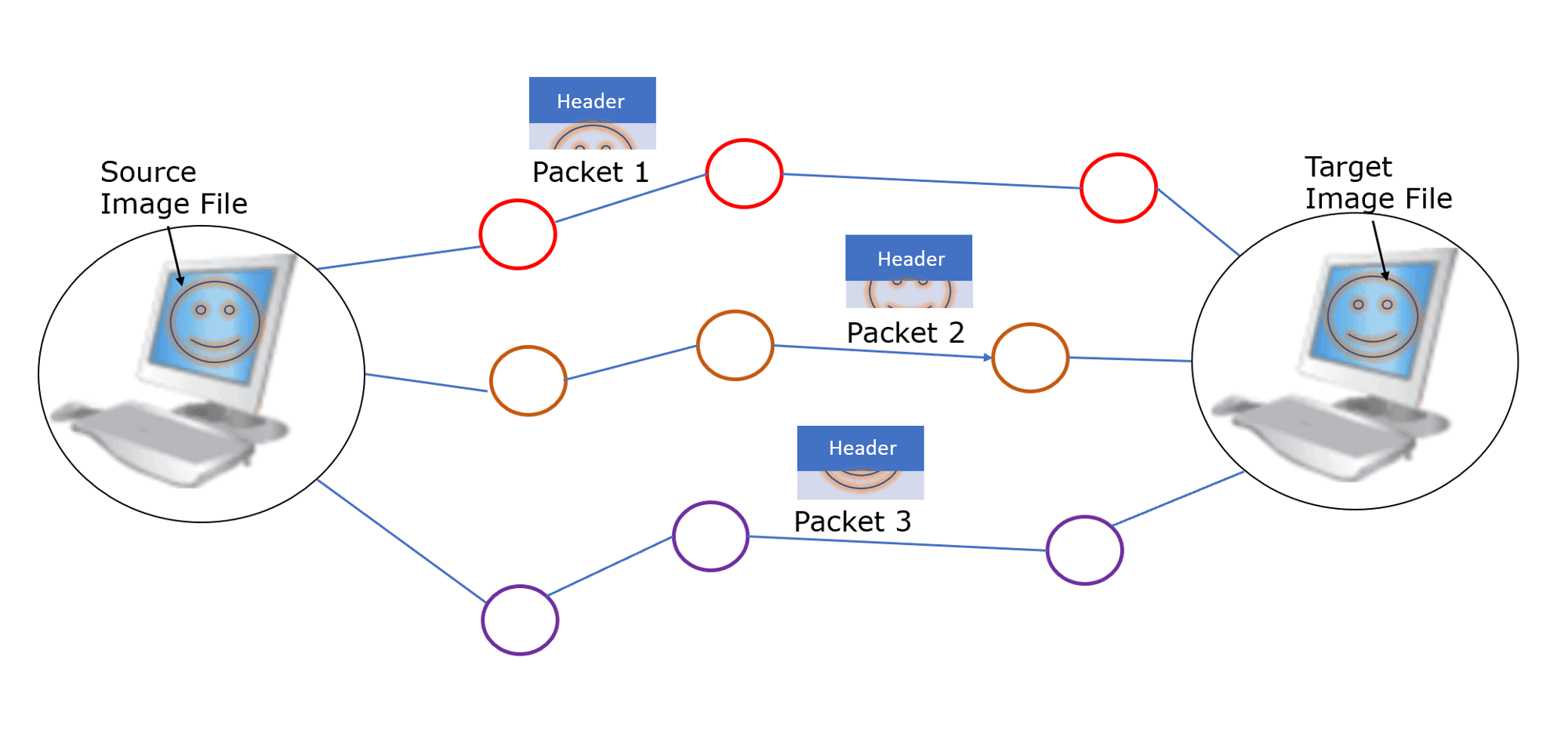1. 引言
传输控制协议(TCP)在建立网络连接时非常有用,尤其在传输文件或消息时。发送方会将文件拆分成多个数据包,接收方则负责将这些数据包重新组装。TCP 单个数据包的最大大小为 64K(即 65535 字节)。不过,实际的数据包大小通常受限于网络资源的 MTU(Maximum Transmission Unit,最大传输单元)。MTU 是网络中硬件设定的数据传输上限,数据包大小不能超过 MTU。
本文将解释这些概念背后的原理,并探讨与 TCP 数据包大小相关的一些关键问题。
2. TCP 连接概述
TCP 连接使用 TCP 协议,是互联网协议套件中最核心的协议之一,提供可靠的数字通信机制。TCP 从网络资源(如服务器、路由器、交换机)接收消息,将其拆分为数据包,并转发到目标网络资源。
几乎所有涉及互联网的连接都使用 TCP。我们以电子邮件通信为例来说明 TCP 的通信过程:

从上图可以看出,一封电子邮件在传输过程中会经过 OSI 模型的七层处理:
- 应用层:邮件客户端通过 SMTP 协议与邮件服务器通信。
- 表示层:将邮件内容转换为 ASCII 文本或图片格式。
- 会话层:建立并维护与目标服务器的连接。
- 传输层:将消息拆分为多个数据包,并添加源和目标端口信息。
- 网络层:通过添加 IP 地址定义数据包的路由路径。
- 数据链路层:准备数据包以便在以太网上传输。
- 物理层:通过 LAN 线缆、Wi-Fi 或宽带等物理连接传输帧。
当数据包到达目标设备的物理层(如上图中的 Host2)后,各层依次处理数据包,最终在目标邮箱中显示邮件内容。
3. 帧与数据包
在计算机网络中,帧(Frame)和数据包(Packet) 是数据传输的基本单位。
- 帧 是比特流的有序集合。
- 数据包 是封装在帧中的分片数据。
在 OSI 模型中,数据包是网络层的单一数据单元,通常包含头部和负载两部分:
- 头部:包含源和目标的 IP 地址与端口号。
- 负载:即实际传输的数据内容。
例如,当我们传输一个图像文件时,文件会被拆分为多个数据包,每个数据包包含图像的一部分。它们各自独立传输,到达接收端后重新组合,恢复成原始图像。

数据包中还包含路由信息和用于校验传输错误和数据完整性的信息。合理拆分数据有助于网络更好地管理带宽、路由路径和设备连接等参数。
4. 数据包大小的重要性
数据包大小直接影响网络通信的性能和稳定性。数据包越大,丢包率越高,对通信参数(如丢包率、吞吐量)也有显著影响。
为确保 TCP 连接性能良好,数据包大小必须小于 MTU。通常,最大数据包大小应在 1500 字节(宽带)到 576 字节(拨号连接)之间。路由器可以从接口配置信息中获取目标连接的 MTU 值。
✅ 优点
- 更高效地利用网络带宽;
- 可根据通信标准使用不同大小的数据包;
- 每个数据包可独立选择最优路由路径;
- 不需要专用通道,可用任意可用路径传输;
- 支持操作系统配置数据包大小;
- 小数据包有助于降低网络延迟。
❌ 缺点
- 数据包大小超过 MTU 可能导致 jabbering(数据冲突);
- 数据包过小可能导致传输速度变慢;
- 最大数据包大小超过网络物理 MTU 会影响性能。
5. 不同 MTU 下的数据包分片
假设源设备通过 TCP 发送一个 IP 数据包,该数据包的大小必须小于目标网络及中间网络的 MTU。否则,数据包将被分片(fragmentation)。
当数据包大小超过中间网络或目标设备的 MTU 时,就会被拆分为更小的片段,这个过程称为分片。接收端会将这些片段重新组合,恢复原始数据包。
但根据使用的 IP 协议类型(IPv4 或 IPv6),分片行为有所不同:
- IPv4:若 Don’t Fragment(DF)标志位为 0,路由器可对数据包进行分片;若 DF 为 1,则不能分片,数据包将被丢弃并返回源设备。
- IPv6:路由器不能对数据包进行分片,只能丢弃并通知源设备。
以下图为例,源 MTU 为 1500 字节,目标 MTU 为 1200 字节,允许分片的情况下,一个 1400 字节的数据包会被拆分为 1200 字节和 200 字节的两个片段:

⚠️ 注意:原始数据包在分片后会被丢弃,数据被重新封装为多个片段进行传输。
✅ 分片的优点
- 减少网络开销;
- 无需进行路径 MTU 探测(PMTUD)。
❌ 分片的缺点
- 丢失一个片段就需要重传整个数据包;
- 第一个片段只包含头部,可能影响依赖头部检查的设备;
- 分片可能导致数据包顺序错乱,需重新排序。
6. MTU 的重要性
MTU 是衡量网络资源能有效接收数据包大小的单位。它是建立 TCP 连接时其他网络必须了解的关键参数之一。
较大的 MTU 能容纳更多数据,减少数据包数量,提高传输效率。但若发生传输错误,重传耗时更长。较小的 MTU 可以提升网络延迟表现。
7. 总结
本文介绍了 TCP 连接中数据包大小的相关概念及其重要性:
- TCP 单个数据包最大为 65535 字节;
- 实际数据包大小受 MTU 限制;
- 数据包过大可能导致分片,进而影响性能;
- 分片有其优点,但也存在重传、重组等潜在问题;
- MTU 是网络性能调优的关键参数之一。
✅ 最终建议:源设备应确保数据包大小不超过目标网络的 MTU,以保障通信的稳定性和效率。